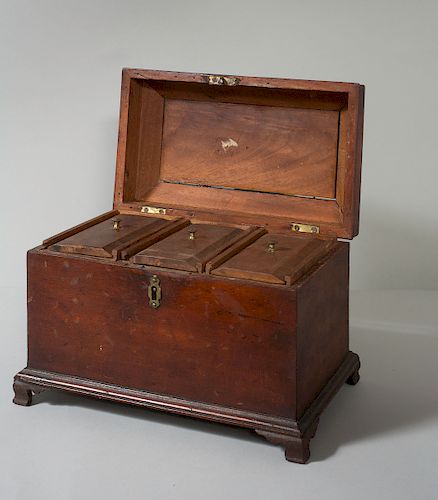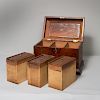RARE CHIPPENDALE MAHOGANY AND TULIP-POPLAR TEA CADDY, American, Probably Philadelphia, Circa 1760-1775
Lot 1
About Seller
Keno Auctions
127 East 69th Street
New York, NY 10021
United States
Keno Auctions is renowned for our expertise in fine and decorative arts. With more than 30 years experience, founder Leigh Keno has established a brilliant team of experts specializing in fine art, furniture, decorative arts and jewelry.
Categories
Estimate:
$1,200 - $1,800
Absentee vs Live bid
Two ways to bid:
- Leave a max absentee bid and the platform will bid on your behalf up to your maximum bid during the live auction.
- Bid live during the auction and your bids will be submitted real-time to the auctioneer.
Bid Increments
| Price | Bid Increment |
|---|---|
| $0 | $25 |
| $100 | $100 |
| $2,000 | $250 |
| $5,000 | $500 |
| $30,000 | $2,500 |
| $50,000 | $5,000 |
| $100,000 | $10,000 |
| $500,000 | $10,000 |
| $1,000,000 | $10,000 |
About Auction
By Keno Auctions
Jan 24, 2020
Set Reminder
2020-01-24 15:00:00
2020-01-24 15:00:00
America/New_York
Bidsquare
Bidsquare : Important Americana – Featuring Furniture and Folk Art from a Distinguished NY Collection
https://www.bidsquare.com/auctions/keno/important-americana-featuring-furniture-and-folk-art-from-a-distinguished-ny-collection-4838
Keno Auctions Leigh@kenoauctions.com
Keno Auctions Leigh@kenoauctions.com
- Lot Description
The term "tea caddy" is thought to be derived from "catty", the Chinese pound, equal to about a pound and a third "avoirdupois". The earliest examples of tea containers that came to Europe were made of Chinese porcelain, and the vessels were similar in shape to the ginger-jar. Tin-glazed ware, scratch blue stoneware, creamware and other types of ceramic containers with lids were used to store tea. The ritual of tea-drinking was, in England, as in the American colonies, an important social activity which showed that one had attained a certain station in life. When one had guests, they most often were seated in the most deluxe area of a home, where one could show ones tea table(s), silver, porcelain and occasionally, their tea caddy. Often called "cannisters" prior to ca. 1800, as the use of the jar waned and that of silver, brass, or the wooden box increased, the provision of different receptacles for green and black tea was abandoned and the wooden caddy, with a lid and a lock, was made with two and often three divisions, the center portion being reserved for sugar, an expensive commodity in the second half of the 18th century. The present box is a very rare example of an American colonial tea caddy. The slightly domed, hinged, locking lid is carved from a single panel of mahogany centered by a hinged, shaped brass pull and enclosed by a sloped, concave molding raised above vertical sides with beaded lower edge, attached to the rectangular case with two brass hinges, the case with two mahogany and poplar partitions helping to separate the three removable mahogany and poplar container boxes, each with an oblong, sliding lid and brass pull. The ogee molding above four ogee-bracket feet with integral shaped returns.The left front foot has been broken and re-glued: the original portion of the ogee-bracket foot has been glued back, the return (which is attached to the molding) is replaced.
Condition
- Shipping Info
-
Buyer Pays Shipping Cost
-
- Buyer's Premium



 EUR
EUR CAD
CAD AUD
AUD GBP
GBP MXN
MXN HKD
HKD CNY
CNY MYR
MYR SEK
SEK SGD
SGD CHF
CHF THB
THB


















